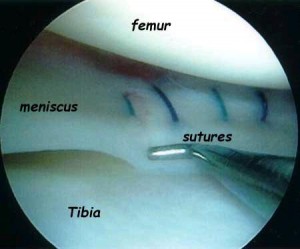60% of Meniscectomies Result in Arthritis Within a Few Years of Removing Parts of the Meniscus with Surgery
Interesting study that shows that 60% of patients who had pieces of their meniscus removed after surgery showed early signs of knee arthritis within years (3.4-8.8 years). Also interesting was that patients who were able to have their knee meniscus repaired fared much better, with only 20% of these patients showing signs of knee arthritis in that time frame. This fits with our prior posts on what happens when pieces of the knee meniscus are surgically removed.
The meniscus is a spacer that helps protect knee cartilage. Cutting out pieces of this meniscus spacer only reduces the protection for the knee joint and leads to a more rapid progression of arthritis. What’s interesting about this study is that the patients who had their meniscus repaired fared better, as I blogged on another study that showed that almost all of these knee meniscus repairs really didn’t heal when you went back into the knee to take another look on arthroscopy. My bet is that what we’re seeing here is simply the fact that leaving torn meniscus tissue in a knee is protective (whether or not the repair actually heals).
The upshot? With stats like 60 of meniscectomies result in arthritis don’t remove meniscus tissue. We can try to repair it surgically, but often that won’t work. However, just leaving it in place and treating these knees non-surgically, in our opinion is a better option than meniscectomy.

If you have questions or comments about this blog post, please email us at [email protected]
NOTE: This blog post provides general information to help the reader better understand regenerative medicine, musculoskeletal health, and related subjects. All content provided in this blog, website, or any linked materials, including text, graphics, images, patient profiles, outcomes, and information, are not intended and should not be considered or used as a substitute for medical advice, diagnosis, or treatment. Please always consult with a professional and certified healthcare provider to discuss if a treatment is right for you.
